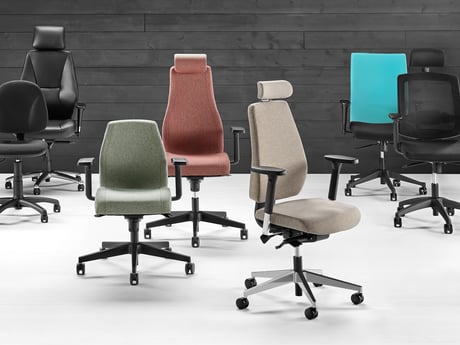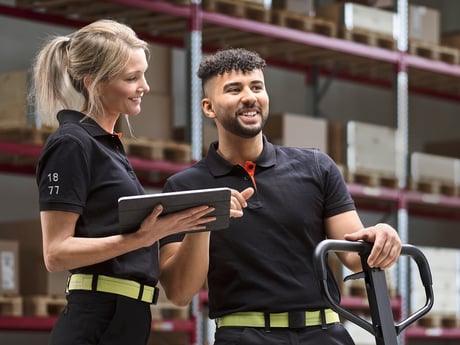How to optimise your warehouse work environment

Fitting out a warehouse is a three-stage process. First you need to install shelving systems and pallet racking to store your goods. Next, select lifting equipment and materials handling tools to facilitate daily work. Finally, you need to add the all-important smaller details to create a safe and easy-to-manage work environment. Here are our tips on how you can achieve that.
Protection for people and machines
Safety should always be a top priority. Creating safe walkways is essential in logistics areas where forklift trucks operate alongside pedestrian workers. High-visibility floor markings can be useful for marking transition points in transport routes but separating vehicle routes from walkways with a physical barrier is always best.
A row of safety bollards is an easy way to create a safe walkway in the warehouse. Alternatively, collision barriers in the form of fully-welded tubular steel arches provide a physical barrier along the length of the perimeter. They are available in different heights and come as straight or corner barriers so they can be fitted as needed. These barriers can also be used around machines, pallet racking and goods to protect them from collisions with trucks or other vehicles operating in the area.
Impact protection for pallet racking
AJ Products’ Ultimate pallet racking is an adjustable racking system ideal for all environments, from small warehouses to large logistics centres that require space for many pallets. But even the most robust pallet racking needs to be protected against accidental damage by vehicles. Pallet racking collision guards bolt to the floor around the base of the rack to protect the frame and/or uprights from damage. These robust steel barriers absorb the full force of any impact to ensure that the stability of the racking itself is not compromised.
Regular maintenance to improve safety
Having a clean and tidy warehouse is important to both employee wellbeing and safety. For example, a gritty floor can increase the risk of slipping. In most warehouses, a manual sweeper is an easy and effective way to clean floors thanks to adjustable brushes and a large waste collection capacity. Look for a model that can be used both indoors and outdoors so that you can also keep loading bays free of slip hazards. Other solutions to reduce the risk of slips and trips include putting down appropriate non-slip mats, which prevent dirt and liquids from accumulating on the surface.
It is also important to have waste collection points throughout the warehouse so that discarded packaging materials cannot provide a trip hazard. Place racksacks® at the end of each pallet racking run so that a bin is always within easy reach or fit trolleysacks® onto your picking trolleys to collect waste on the move.
Easy solutions for recycling at source
In order to make your business more sustainable and compliant with environmental guidelines, it’s important to separate waste streams to recycle as much as possible.
Wheelie bins in different colours can be an easy way to segregate waste. Made from impact-resistant HDPE with a sturdy, easy-grip handle and large wheels, these large-capacity waste bins are easy to empty and clean. When it comes to emptying the wheelie bins, a tipping skip can collect a large amount of waste before it needs to be emptied, which can be done by lifting it with a forklift and tipping into a suitable receptacle. Like the wheelie bins, skips are available in several different colours to facilitate waste sorting at source.
By adding these important details, you can optimise your warehouse into a safe and efficient working environment.


